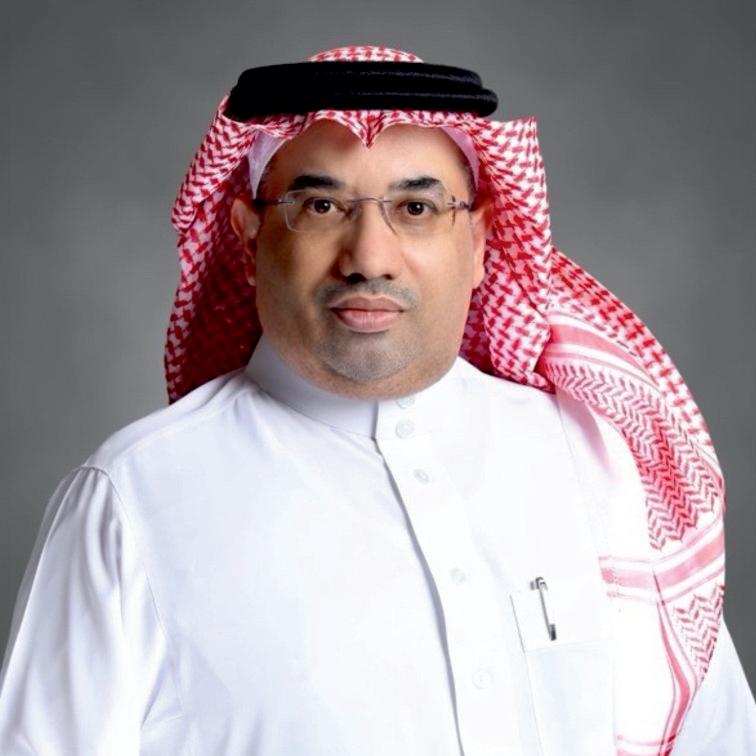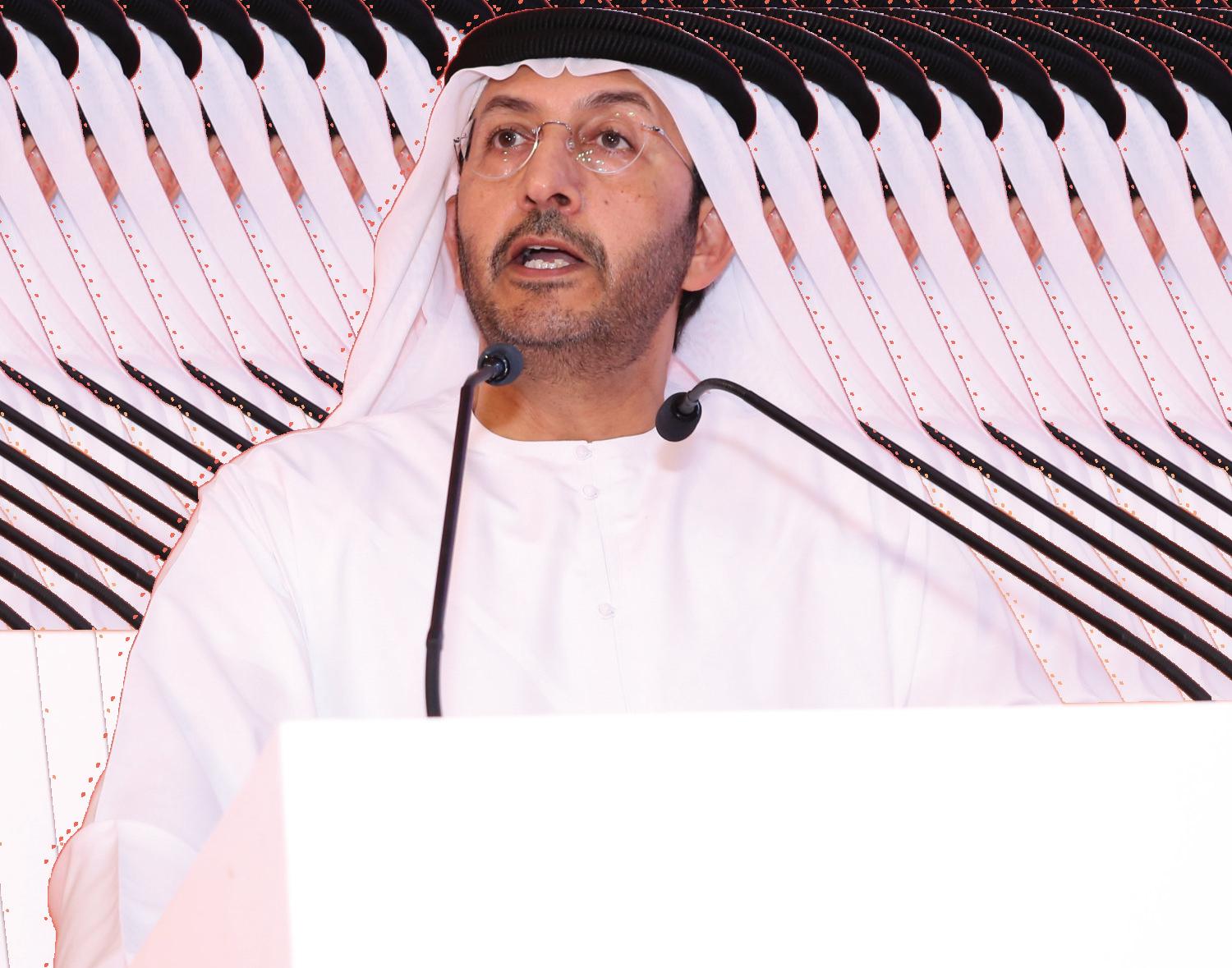












Inaworldhungryforpurpose-drivenleadershipand
authenticinfluence,itisraretoencounterindividuals whonotonlyrisetoprominencebutdosowith integrity,compassion,andarelentlessdrivetomakea difference.AhmadAldahamstandsasabeaconofsuch rareinspiration.AsInsightsSuccessunveilsthisspecial edition, Inspirational Icon to Look For in 2025,weare proudtospotlightamanwhosejourneytranscends professionalsuccess—itembodiesthespiritofresilience, vision,andempowerment.
Ahmad’sstoryisnotjustaboutpersonalaccomplishments; it'saboutliftingothersalongtheway,creatingmeaningful impactineveryspherehetouches—frombusiness innovationtocommunityleadership.Hisapproachreminds usthatinfluenceisnotmeasuredsolelybyreach,butbythe depthofimpactwemakeinpeople’slives.
Thiseditiongoesbeyondtitlesandachievementsitis exploringthemindset,values,andunwaveringcommitment thathaveshapedhimintotheleaderheistoday Through hisvoice,weseeareflectionofthefutureonewhere leadershipisgroundedinauthenticityanddrivenby service.
Whetheryouareanaspiringentrepreneur,achange-maker, orsomeoneinsearchofmotivation,hisjourneyisoffering lessonsworthholdingonto.Asyouturneachpage,may youfindasparktochaseyourownpurposewithrenewed courage.
Here’stocelebratingleadershipthatinspires,andtothose likeAhmadAldaham—whoareshapingabrighter tomorrow
Happy Reading!


Ahmad Aldaham
The Visionary CFO Redening Financial Leadership in Saudi Arabia F E A T U R I N G
18
Common Pitfalls in Finance Transformation Strategy Implementation and How to Avoid Them
The Evolution of Corporate Financial Strategy in Post-Pandemic Business Models

Art
Business
Business
Digital
Co-designer
Marketing

















Chief Shared Services Officer FMTECH







IIn a time when agility, inventiveness, and purpose are
frequently used to gauge leadership, AhmadAldaham stands out as a potent example of transformative leadership in Saudi Arabia's changing economic environment. He is contributing more than just financial expertise to his role as Chief Shared Services Officer at FMTECH,aPublicInvestmentFund-backedcompanyinthe facilities management industry With his extensive knowledge of company development, operational strategy, and human capital stewardship, he is embodying a new generationofleadersinfluencingtheKingdom'sfuture.
Aldaham's capacity to lead through complexity with poise, vision,andethicsiswhatmakeshimunique,inadditiontohis gradual ascent from junior accountant to C-suite executive. Hisleadershipstyle,whichisbasedonapassionforhavinga significant effect and ongoing learning, blends humancenterednesswithstrategicvision.Heisconstantlyexhibiting a wonderful balance between analytical rigor and compassionateleadership,whetherheishandlinghigh-stakes companytransitionsornavigatingdigitaltransformation.
His path is distinguished by his unshakeable conviction that promotinglong-lastingchange,ratherthanobtainingtitles,is thetruemeasureofaccomplishment.Heisarespectedleader inseveralindustriesbecauseofhisdedicationtoprofessional development, which is demonstrating by his pursuit of executive education and unrelenting self-improvement Today,inadditiontooverseeingcommercialoperations,heis creating a model for responsible leadership in the contemporary Middle East by playing a crucial part in coordinating FMTECH's shared services with the larger objectives of Vision 2030. He is leading with resiliency, purpose,andlegacyinmind,nomatterwhat.
Aldaham's story begins with a solid educational foundation. Graduating from King Saud University's College of AdministrativeScienceswithamajorinaccountingin2001, he understood early that success in the financial world required more than just technical knowledge. Today, as he pursues his Master's degree in Executive Business Administration from Imam Abdulrahman bin Faisal University,Aldaham continues to embody the principle that learningneverstops.
"I gained the foundational knowledge that paved the way for my professional journey," Aldaham reflects on his early academic years. This commitment to continuous education has remained a cornerstone of his professional philosophy, driving him to seek specialized courses in finance and risk managementthroughouthiscareer
I faced challenges related to managing remote teams and ensuring business continuity. I relied on strategies such as enhancing digital communication and adopting new project management tools.
Aldaham's professional journey reads like a masterclass in strategiccareerdevelopment.Startingasajunioraccountant at one of Saudi Arabia's largest local pharmaceutical manufacturing companies, he quickly distinguished himself through his analytical skills and innovative approach to financialmanagement.Hisprogressionthroughtherankswas neitheraccidentalnormerelyduetotenure,itwastheresultof consistent excellence and a deep understanding of business dynamics.
"I discovered my passion for numbers early on. The idea behind my choice of this field was the desire to understand how to manage money, forecast, and engage in financial and strategic planning " Aldaham explains. This passion propelled him from his initial role to the position in a subsidiaryrepresentingtheinvestmentarmofthegroup.
His career trajectory took another significant turn when he transitioned to the role of Chief Financial Officer at a jointstock company in the food manufacturing sector.Thismove demonstrated his versatility and ability to adapt to his financial expertise across different industries, a skill that wouldproveinvaluableinhiscurrentrole.





Today, Aldaham serves as the Chief Executive Officer of Shared Services at one of the newly established Public Investment Fund companies in the facilities management sector This position places him at the forefront of Saudi Arabia'sVision2030initiatives,whereheplaysacrucialrole inshapingtheKingdom'seconomicdiversificationefforts.
His current role represents more than a career milestone; it symbolizes his evolution from a financial specialist to a strategic business leader capable of driving organizational transformation.Thefacilitiesdevelopmentfor,beingintegral totheKingdom'sinfrastructuredevelopment,requiresleaders who can navigate complex financial landscapes while maintainingoperationalexcellence.
One ofAldaham's most remarkable qualities is his approach to work-life balance—a challenge that many executives strugglewithintoday'sdemandingbusinessenvironment. "I believe in the importance of balancing work and life. I dedicate time to family and friends, as I find that it enhances myproductivity."hestates.
Hismethodologyforachievingthisbalanceisbothpractical andstrategic.Heemploystimemanagementtechniquessuch asprioritizingtasksandorganizinghisschedulemeticulously When facing professional challenges, Aldaham has developedasystematicapproach: "I make sure to write down the problem, study it, and analyze each phase, and I utilize moderntechnologytofindthebestsolutions."
This balanced approach extends to his personal wellness practices.Hesetsasidetimeforrestandreflection,takesshort walks, and engages in hobbies like reading. "By exercising and paying attention to mental health, I can maintain a high level of energy and focus," he explains, recognizing that sustainablesuccessrequirespersonalwell-being.
WhatsetsAldahamapartfrommanyfinancialprofessionalsis his broader vision of business impact. "My passion for business stems from my desire to make a positive impact on society Ibelievethatbusinessisnotjustaboutmakingprofits, butitisameanstoimprovethequalityoflife."heexplains.
Thisphilosophydriveshisapproachtofinancialmanagement and strategic planning He sees every project as an opportunity to create value beyond mere financial returns, focusingonsustainablegrowthandsocietalbenefits.
I discovered my passion for numbers early on. The idea behind my choice of this field was the desire to understand how to manage money, forecast, and engage in financial and strategic planning.
Hispassionforcreativityandinnovationinbusinesshasled him to consistently seek new solutions that align with everchangingmarketchallenges.
"I love being part of teams that strive to develop new solutions. I believe that innovation is the key to success in the fast-paced business world, and I continuously work on enhancingmyskillsinthisarea."Aldahamnotes.
TheCOVID-19pandemictestedbusinessleadersworldwide, and Aldaham's response exemplified adaptive leadership. Ratherthanmerelysurvivingthecrisis,hetransformeditinto anopportunityforgrowthandinnovation."Ifacedchallenges related to managing remote teams and ensuring business continuity I relied on strategies such as enhancing digital communication and adopting new project management tools."herecalls.
His pandemic response strategy included a comprehensive digital transformation approach. He reevaluated marketing strategies to increase digital presence, invested in online advertisingcampaigns,andorganizedtrainingworkshopsfor employeestoenhancetheirremoteworkskills.Thisproactive approach not only maintained business continuity but also positionedhisorganizationforfuturegrowth.



By focusing on innovation and flexibility, he was able to maintain the team morale and ensure that they met business objectives despite the difficult circumstances These experiences reinforced his belief in the importance of rapid adaptationandinnovationinthefaceofcrises.
Aldaham's self-awareness regarding his strengths and areas for improvement reflects mature leadership thinking. He identifies his ability to make strategic decisions and strong leadershipskillsaskeystrengthsthathavecontributedtohis success. However, he also acknowledges areas for growth withremarkablehonesty
"I have weaknesses, such as my constant desire to achieve results as quickly as possible and with the highest quality Sometimes, I feel that there is always room for improvement, which can put pressure on the team. This awareness has led me to focus on developing patience and flexibility in teamwork.”headmits.
Hiscommitmenttolearningfromeveryexperience,whether positive or negative, demonstrates a growth mindset that is essential for sustained leadership success. "I believe that every experience carries an important lesson. I always strive to analyze these experiences and extract lessons from them, whichhelpsmeimprovemyperformance."hestates.



My passion for business stems from my desire to make a positive impact on society. I believe that business is not just about making profits, but it is a means to improve the quality of life.
Aldaham's advice to aspiring leaders is reflecting his comprehensive understanding of what it takes to succeed in today's business environment. "I advise others to cultivate passion and ambition, and not to hesitate in seeking opportunities Learn from failure and benefit from past experiences. Stay open to change and always be ready to developyourskills."hecounsels.
His leadership philosophy emphasizes the importance of building strong professional relationships and maintaining opennesstodiverseperspectives."Takeeveryopportunityto connect with people in your field, as this can open new horizonsforyou,"headvises."Makesuretolistentodiverse opinions,asavarietyofideashelpenhancecreativity."
Lookingahead,Aldaham'smessagetoaspiringprofessionals isbothinspiringandpractical: "Success is not the end of the road; it is a continuous journey Keep learning, embrace challenges,andalwaysbereadytoevolveandgrow."
His emphasis on flexibility and adaptability reflects his understandingoftherapidlychangingbusinessenvironment. Learninghowtoadapttochangingcircumstancescanbethe keytosuccess.Additionally,investinginhumanrelationships enhancesopportunitiesforsuccessinbusiness.
As Ahmad Aldaham continues to make his mark in Saudi Arabia'sbusinesslandscape,hisstoryservesasaninspiration tocountlessprofessionalsseekingtomaketheirownimpact. His journey from a junior accountant to a chief executive officerisdemonstratingthatsuccesscomesnotfromasingle breakthrough moment but from consistent excellence, continuouslearning,andthecouragetotransformchallenges intoopportunities.
In a Kingdom undergoing unprecedented economic transformation, leaders like Aldaham represent the new generation of Saudi business professionals those who combine technical expertise with strategic vision, financial acumenwithsocialresponsibility,andprofessionalambition with personal balance. His recognition among the Top 100 Financial Managers in Saudi Arabia for 2025 is not just a personal achievement but a testament to the caliber of leadershipdrivingtheKingdom'seconomicfuture.
I have weaknesses, such as my constant desire to achieve results as quickly as possible and with the highest quality. Sometimes, I feel that there is always room for improvement, which can put pressure on the team. This awareness has led me to focus on developing patience and flexibility in teamwork.

ThroughhisworkataPublicInvestmentFundcompanyand hisbroadercontributionstothebusinesscommunity,Ahmad Aldahamcontinuestoembodytheprinciplesthathaveguided his journey: passion for excellence, commitment to innovation, and an unwavering belief that business success mustcontributetosocietalprogress.Ashecontinuestowrite hisprofessionalstory,onethingremainsclearthatAldahamis notjustmanagingfinances;heishelpingtoshapethefutureof SaudiArabia'seconomy.









In today's rapidly evolving business environment, an effective finance transformation strategy is not just a competitive advantage—it's a necessity. Businesses are under unprecedented pressure to do more with less, and the financeorganizationsarechallengedwithbecomingcatalysts of growth, speed, and effectiveness. And yet, as finance transformationincreasesinimportance,mosttransformation initiatives fail because of expensive and unnecessary missteps.
Let us discuss the most prevalent pitfalls encountered during the adoption of a finance transformation strategy and how companiescanbestovercomethem.
1.AbsenceofClearVisionandObjectives
The most prevalent cause of the failure of the finance transformation program is the absence of a clear vision and defined objectives. Companies undertake transformation programswithoutbringingtheleadershiptogethertoagreeon whatwinningwillbe.
HowtoAvoidIt:
Startwithahigh-levelstrategicvisionthatsetsoutthefinance transformation strategy's long-term goals. These must be directly connected to business objectives, such as improved forecasting, greater automation, or improved support to decisions. Involve important stakeholders early on to obtain alignmentandsign-offatdepartmentallevel.
2.UnderestimatingtheCulturalShift
Itisnotjustacaseofpurchasingnewprocessesortechnology to implement a finance transformation plan; there is an underlyingchangeinculturetoo.Financeteamshavedeeply rootedbehaviors,andoppositiontochangecanmakeeventhe bestintentionsworthless.
HowtoAvoidIt:
Change managementmust be included in the plan. Describe the"why"ofthechange,engageteamsatlevels,andprovide ongoing support and training. Empower finance function leaderstodrivethechangeandbecomeagentsofchange.
Data is the cornerstone of any successful finance transformationprogram.However,themajorityofcompanies possess unconnected systems and combined data sources, leading to erroneous reporting and less-than-optimal decision-making.
HowtoAvoidIt:
Invest in data governance and establish a single source of truth. Conduct full data audit before onboarding new processes or technologies to identify gaps and inconsistencies Reduce data sources, enable proper integration between platforms, and build standardized reportingtemplates.

Most firms associate finance transformation with the installation of new technologies ERP packages, AI analytics, or cloud platforms without any strategy for integratingthem.Thiswillleadtotooloverload,inefficiency, anduserfatigue.
HowtoAvoidIt:
Technology must be an instrument, not a goal. Ensure that everypieceoftechnologyinvestmentisplayingitspartinthe overallfinancetransformationagenda.Employsolutionsthat scale and integrate well with current infrastructure and seek tools that stimulate high levels of automation, visibility, and teamwork.
5.TalentDevelopmentForgetting
Anew finance role for the twenty-first century requires new skills data analytics, strategic thinking, digital literacy which might not reside in existing finance organizations. Few transformation strategies are treating talentdevelopment.
HowtoAvoidIt:
Seekcapabilitygapscurrentlyandcreateawinninglearning and development strategy as part of the finance transformation plan Promote cross-functional visibility, invest in up-skilling programs, and recruit strategically to place individuals in the most critical positions. Your technologyisonlyasgoodastheindividualswhoareusingit.
6.ExecutiveSponsorshipdoesnotexist
Successful finance transformation requires energetic, ongoing support from top leaders. Senior leaders must be strongly on board or championing the program to keep momentumstrong.
HowtoPreventIt:
Secureearlysponsorshipoftop-levelstakeholders.Executive leaders not only need to approve the finance transformation strategy but also actively champion the need, participate in key milestones, and provide the resources necessary to be successful.
Change is a long, meandering path. Not yielding quick, visibleoutcomescandisillusionstakeholdersandchipaway atconfidence.
Break the finance transformation plan into bite-sized, manageable steps. Seek out ways to gain early victories e g , automating a manual process or condensing a reportingprocess—andtoutthoseearlyvictories.Thisbuilds momentum and demonstrates the value of the change to the wholeorganization.
Transformationisanongoingprocess,notasingleproject,but many organizations fail to track progress against goals or changeinresponsetochangingconditions.
Developkeyperformanceindicators(KPIs)andagovernance framework to track the implementation of your finance transformation strategy. Review progress regularly, listen to customer feedback, and be prepared to change direction as necessary Improvement needs to be part of the transformationprocess.
Conclusion:CreatingaResilientFinanceFuture
A well-conceived finance transformation strategy has the power to turn the finance function into a forward-looking, fact-driven engine of business success. But if the effort is to reach its potential, avoiding the common pitfalls—vague goals,poor-qualityinformation,culturalresistance,andskill gaps—isessential.
Only those firms that tackle transformation holistically obtaining the people, process, and technology mix right—will be well positioned to achieve their complete transformation potential. With intelligent planning, strong leadership, and an unrelenting value focus, finance leaders can build lasting transformation and unleash new levels of performanceandflexibility

SinceCOVID-19,businesshasalteredbeyond recognition.Theestablishedfundamentalsof conventionalfinancialplanningandcorporatedesign werepushedtothelimitasneverbefore.Whilecompanies foughtforsurvival,learnedtoadapt,andfinallyprospered inthenewworld,therewasonedisciplinethatwasthe tippingpointindealingwithuncertainty:corporate financialstrategy
Today,thisoriginalworkhorseoforganizationalplanningis anevenmoreadaptable,tech-enabled,andmission-driven functionattheveryheartofbusinessresiliencyandlongtermsuccess.
Thecrisisputbusinessesintosurvivalmode.Liquiditytook centerstage,andshort-termcost-cuttingwasparamount. Sureenough,withafewexceptions,mostfirmshadtoact inhaste,slashingoperatingcosts,renegotiatingsupplier contracts,oraccessingemergencyfunds.Itwasawake-up call,aswell,though,asCFOsandfinanceleaderswere compelledtorethinkhowfinancialstrategywasbeing developedandimplemented.
Corporatefinancialstrategyinthepost-pandemicworldis notjustbudgetingandforecastinganymore.Ithasbecome highlylinkedtoorganizationalgoals,withdigitalization,
workforceplanning,riskmanagement,andsustainabilityat thetop.Today'sfinancialleadersarenotcapitalguardians, butend-to-endgrowthstrategists.
Itisnowanaturalpartoffinancialplanninginthemodern era.Long-horizonplanningcyclesofthepasthavebeen displacedbyresponsiveforecastmodelsthatincludemany scenariosandexternalshocks.Thistransitionmirrors greateracceptanceofvolatilityasthenorm,notthe exception.
Post-pandemicbusinessfinancestrategyisanongoing rethink.Technologyadvancessuchasrollingforecasts, zero-basedbudgeting,andpredictiveanalyticshavemore centralrolestoplay,withcompaniesabletorespondinreal timetoshiftsinthemarketplace.Financialagilitymeans thatfirmsarenotcaughtunawaresbutareabletoadapt withoutunderminingtheircoremissions.
Digitalizationisamongtheprimarydriversthatare speedingupcorporatefinancialstrategy.CloudERP,realtimedashboards,AI-drivendataanalytics,andRPAarenow thenewnormalweaponryforaCFO.Theyprovide improvedvisibility,accuracy,andvelocityindecisionmaking.
Also,analyticshasmovedontopredictiveandprescriptive models.Leadersinfinancearenowinapositiontoforecast outcomes,understandriskexposure,andmaximizecash flowmanagementwithhigheraccuracythaneverbefore. Suchtechnology-driventhinkingreducesroomforerror andenhancesstakeholderconfidence.
Anothersignificantpost-pandemicshiftissynchronization offinancialplanningwithwidercorporatepurposeandESG factors.Investors,customers,andregulatorsaremoreand moredemandingaccountabilityfromcompaniesfortheir focusonethicalandsustainablebehavior
Awell-capitalizedcorporatefinancialplantodayinvolves thepricetagofESGprograms,whetheritiscarbonprofiles reduction,workforcediversityenhancement,or philanthropicinvestments.Thejoboffinancialplannersis todeterminetheROIonsucheffortsandintegratetheminto overallcapitaldeploymentplans.
Thepandemicledtoare-thoughtintheworkforceapproach andoncapitalallocation.Telework,blendedmodels,and employeewellnessneedshavedrivenhumancapital investment.Today'sfinancialstrategiesneedtofactorin upskilling,flexibledesignbenefits,anddigitalinfrastructure tosupportremotework.
Equally,capitalallocationisnowfocusedondigital initiativesandresearchanddevelopmentspendinginstead ofphysicalexpansion.Capitalspendingunderthenew methodologyismostlylinkedwithinnovationpipelinesand long-termstabilityasopposedtoshort-termpayback.
ThepositionoftheChiefFinancialOfficerhaschanged significantly Theyusedtobeseenasmainlyacustodianof records,whiletodaytheCFOisatransformationalbusiness partner.FromtakingcareofM&Adecisionstoadvisingon comingupwithdigitalproducts,theCFOpositionisnow moreintermsofcollaborationandthinkingahead.
Thisleadershipevolutionisaresponsetoshifting expectationsregardingcorporatefinancialstrategy.Itisnot justaboutcontrolandcomplianceanymorebutabout innovation,vision,andvaluecreationthroughoutthe enterprise.
Risktolerancetoohasbeenredefined.Post-pandemic situationshaverevealedrisksalongsupplychainsinthe world,incybersecurity,andinmarkets.Therefore,today's financialplanshavemoreeffectiverisk-assessmentmodels. Scenarioanalysisandstresstestingaretypicalpracticesto keepcompaniesinhealthyfinancialshapeduring disruption.
Moreover,insuranceplanning,disasterrecoveryplanning, andcybersecurityexpenditurenowformpartofthe financialplanningframework,andthesereflecthow corporatefinancialstrategytodayincludesriskasmuchas prudence.
Corporatefinancestrategyformulationisnotcomplete.In thenextfewyears,someofthesearegoingtomeet stakeholdercapitalism,climateriskreporting,and regulatorychangesabroad.Companieswillhaveto formulatemorefinancialstrategiesthat,inadditionto creatingshareholdervalue,contributetothebettermentof thesocietiesinwhichtheyarelocated.
Theintersectionofstakeholderinterests,digitalinnovation, andresilienceplanningwilldefinestrategicfinancegoing forward.Financialexecutiveswillneedtocountershorttermflexibilitywithlong-termforesight,soprofitability alignswithpurpose.
Businessafterthepandemicneedsawholenewmindset whenitcomestofinance.Whatwasonceaback-office exerciseisnowacentralsourceofinnovation,resilience, andpurpose.Ascompaniesshapeanageofcomplex disruptionsandchangingexpectations,asolidlydesigned, dynamic,andlinkedcorporatefinancialstrategyisnotonly desirable—it'sindispensable.
Thefutureisgoingtobeownedbythosecompaniesthat understandthestrategicpoweroffinanceanddeployitasa weapontonotonlysurvivethestormbutleadthestorm.












For Subscrip�on: www.insightssuccessmagazine.com
www.x.com/insightssuccess

